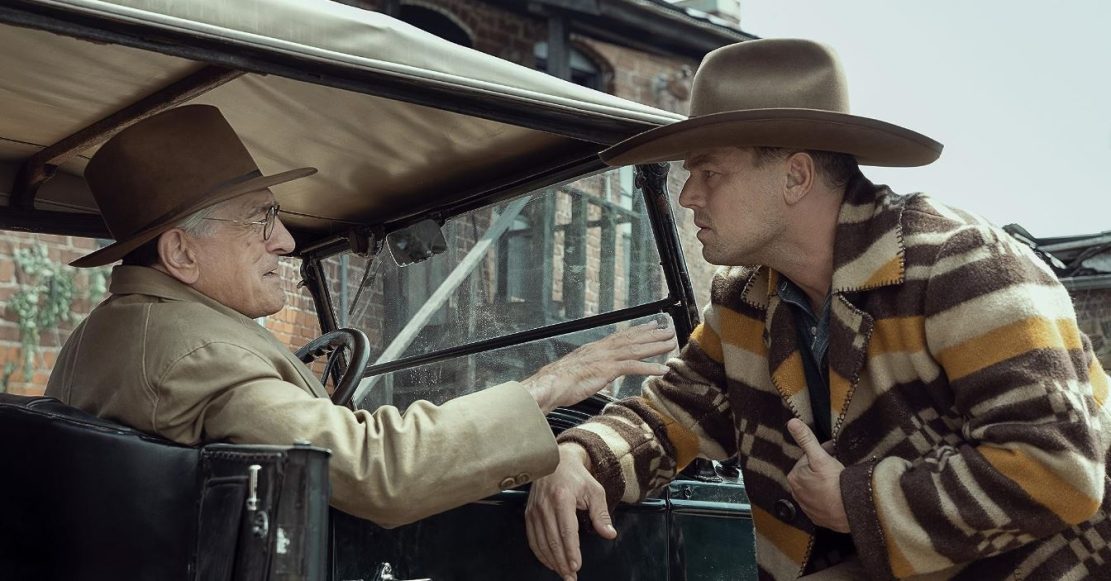| Worth seeing: | for Leonardo DiCaprio's conflicted turn as a First World War veteran, who gets inadvertently caught up in one of the most infamous murder conspiracies of the early 1900s |

| Director: | Martin Scorsese |
| Featuring: | Leonardo DiCaprio, Robert De Niro, Brendan Fraser, Cara Jade Myers, Everett Waller, Janae Collins, Jason Isbell, Jesse Plemons, Jillian Dion, John Lithgow, Lily Gladstone, Louis Cancelmi, Pete Yorn, Scott Shepherd, Steve Routman, Steve Witting, Sturgill Simpson, Talee Redcorn, Tantoo Cardinal, Tatanka Means, Tommy Schultz, Ty Mitchell, William Belleau, Yancey Red Corn |
| Length: | 206 minutes |
| Certificate: | 15 |
| Country: | US |
| Released: | 20th October 2023 |
WHAT’S IT ABOUT?
It’s 1920s Oklahoma and the Osage Native American tribe has become very wealthy since oil was discovered on their reservation.
A white local rancher, Bill Hale (Robert De Niro), has won the trust of the tribe and lives on the reservation, quietly making money from no-one quite knows where, but no-one asks questions, as he offers financial support to people across the community, Osage and whites alike.
When his nephew Ernest (Leonardo DiCaprio) leaves the army, he moves in with his uncle and falls in love with a local Osage woman, Mollie (Lily Gladstone).
Ernest marries Mollie and starts a family – he’s sure he married her for love, but Hale keeps reminding him that if a member of the Osage tribe were to die, their shares in the oil rich land would pass to their spouse.
When Mollie’s diabetes starts causing her problems, Hale provides some medicine for Ernest to give her – but she gets worse, not better.
WHAT’S IT LIKE?
Little known outside the US, the Osage murders of the 1920s saw members of the local Native American community dying – in unexplained circumstances – and for many years, it didn’t seem to occur to the authorities that the oil rights of the victims were passing to their white spouses. The case of Mollie Burkhart was part of the process that finally saw the authorities catch on to what was happening.
Over the course of 3 and a half hours, Martin Scorsese turns Robert De Niro’s Bill Hale from a cuddly uncle into the ruthless, greedy head of a conspiracy, trying to steal the oil wealth from its rightful owners.
At the heart of the story is Leonardo DiCaprio’s Ernest – naive and easily led – he genuinely believes he’s in love with Mollie, but can’t resist the pull of his sinister uncle.
As Scorsese adapts a book that exposes a conspiracy of murder and theft that horrified Americans in the early 20th Century, his two leading men fall comfortably into their respective roles as a smarmy, villainous gangster – who knows how to keep his hands clean – and his inexperienced young charge, who does everything for love – despite loving people on both sides. Or perhaps his fear of his uncle is stronger than his love for his wife.
In reality, Ernest’s character might not have been quite so empathetic – but despite a little too much gurning, DiCaprio’s inner turmoil is part of what makes his emotional journey so fascinating.
But oddly, despite tackling a major scandal and describing one of the great racial injustices of early 20th Century America, the Killers of the Flower Moon doesn’t have the heft – the epic quality – of some of Scorsese’s earlier modern-day classics. Maybe the young De Niro was a more compelling protagonist than DiCaprio – maybe it’s more enthralling to have the central character being more active than passive – or maybe it’s the length.
At 3 and a half hours, it’s inexcusably long, as Scorsese indulges his sense of justice – but however shocking the story – and he’s told shocking stories many times before – films don’t need to be this long. Whether he’s becoming ill-disciplined in his old age, perhaps losing the courage of his convictions or maybe he’s just becoming a little lazy, he’s forgetting two of the fundamental elements of film-making – editing the screenplay and editing the finished film.
I’m clearly not in a position to lecture Martin Scorsese on film-making – he’s as learned as an academic as as a director – but a snip here and there might have helped the narrative flow.
